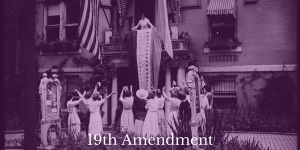19th Amendment

The student will examine the ratification of the Nineteenth Amendment to the U.S. Constitution granting women voting rights. Students will discuss the ratification process and place the Nineteenth Amendment in a global context by comparing the dates of voting rights worldwide.
30 minutes (The lesson can also be lengthened into a 45-60 minute class lesson by having students first research the arguments surrounding state vs. federal campaigns for suffrage.)
Students will understand the ratification process and place the Nineteenth Amendment in a global context.
- Transcript of the 19th Amendment from the Library of Congress
- Map of World Suffrage from Library of Congress
- List of Countries and Voting Rights via Women Suffrage and Beyond
- Map of Ratification via Equal Rights Amendment
- Construction Paper (Cut into small squares in two different colors)
- Starter/Hook: As students enter the classroom, distribute the slips of construction paper. Be sure to randomly assign a color to each student. You can distribute the slips equally or in an uneven fashion. To begin, tell the class that they will vote on an issue (Example: whether to have homework that evening) that impacts all students but only students who have one of the color slips will actually be able to vote. Take a vote and see what the results are, then ask the students if it is fair for a few students to make decisions for the entire class. Tell the class that this is what happened before the passage of the Nineteenth Amendment.
- Direct Instruction:
- Provide background on women’s suffrage movement from 1900 to 1920 to the class. Explain to them that before the passage of the Nineteenth Amendment, women could vote in certain states, but there was not a federal law allowing for voting rights. Explain that other countries in the world (see map) allowed women to vote.
- Use the NWHM’s “Crusade for the Vote” to provide background information:
- Guided Practice:
- Students can identify countries that allowed women voting rights and create a list of reasons why those countries might have allowed women the right to vote
- Students will examine the Nineteenth Amendment and in groups discuss why this amendment might have been controversial during this time period. Groups will share their ideas with the rest of the class.
- Have students examine the Map of Ratification and discuss why certain states would not have wanted women to vote. Groups will share their ideas with the rest of the class.
Students will pick one of the states that did not ratify the Nineteenth Amendment to the Constitution and research when/if the state ever ratified this amendment.
Optional: To extend this activity, have students write an essay on the topic and cite their evidence.
UCLA Social Studies Standard 1C: Specify the issues raised by various women and how mainstream Progressives responded to them. [Consider multiple perspectives]
UCLA Social Studies Standards Available Here
Common Core Alignment
CCSS.ELA-LITERACY.RH.9-10.1 - Cite specific textual evidence to support analysis of primary and secondary sources, attending to such features as the date and origin of the information.
CCSS.ELA-LITERACY.RH.11-12.1
Cite specific textual evidence to support analysis of primary and secondary sources, connecting insights gained from specific details to an understanding of the text as a whole.
